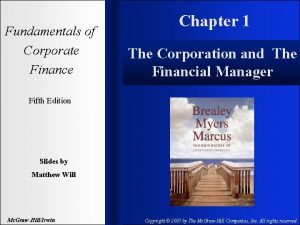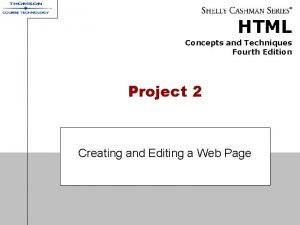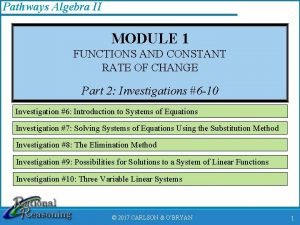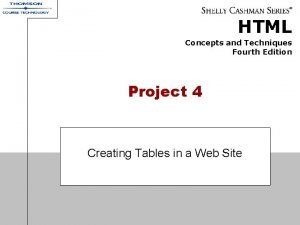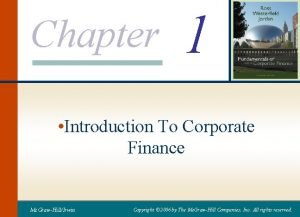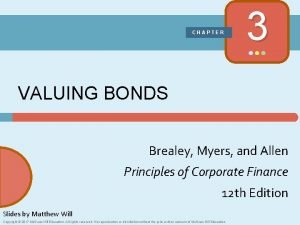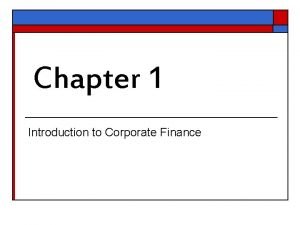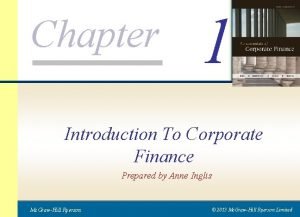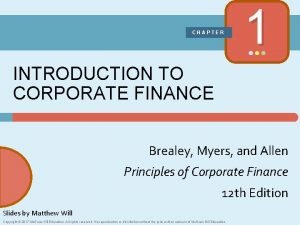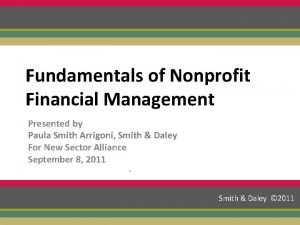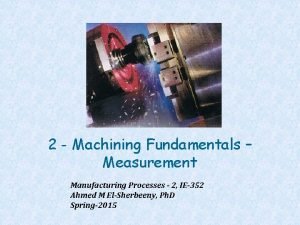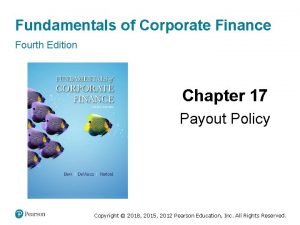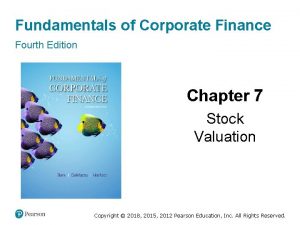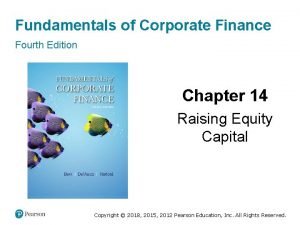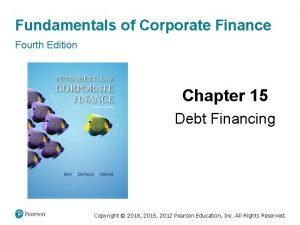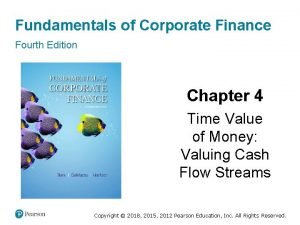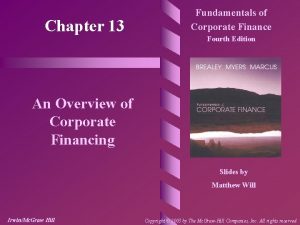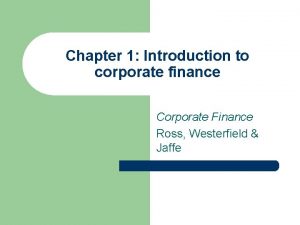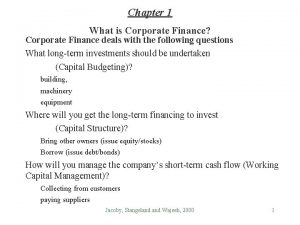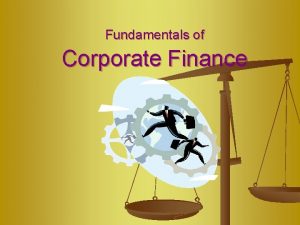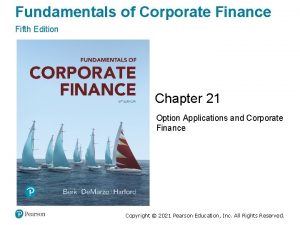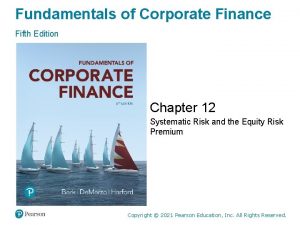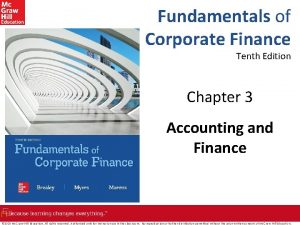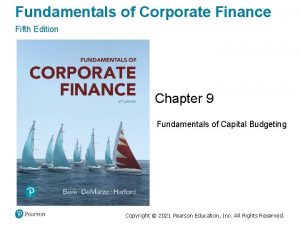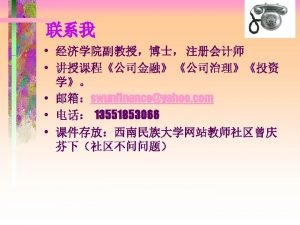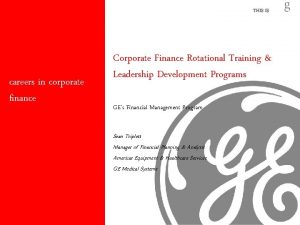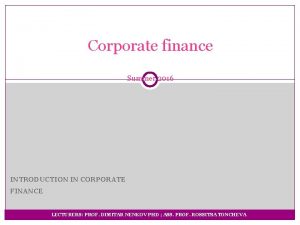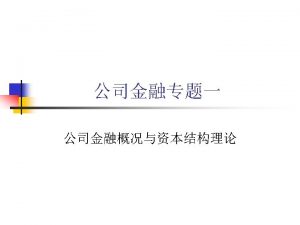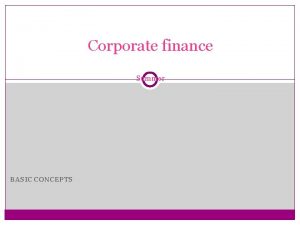Fundamentals of Corporate Finance Fourth Edition Chapter 13


































- Slides: 34

Fundamentals of Corporate Finance Fourth Edition Chapter 13 The Cost of Capital Copyright © 2018, 2015, 2012 Pearson Education, Inc. All Rights Reserved.

Figure 13. 2 Two Capital Structures Source: Authors’ calculations based on publicly available data in 2016. Percentages are based on market value of equity. Copyright © 2018, 2015, 2012 Pearson Education, Inc. All Rights Reserved.

13. 1 A First Look at the Weighted Average Cost of Capital (2 of 5) • Opportunity Cost and the Overall Cost of Capital • Weighted Averages and the Overall Cost of Capital – Weighted Average Cost of Capital (WACC) – Market-Value Balance Sheet Market Value of Equity + Market Value of Debt = Market Value of Assets (Eq. 13. 1) Copyright © 2018, 2015, 2012 Pearson Education, Inc. All Rights Reserved.

13. 1 A First Look at the Weighted Average Cost of Capital (5 of 5) • Weighted Average Cost of Capital Calculations – The Weighted Average Cost of Capital: Levered Firm (Eq. 13. 2) Copyright © 2018, 2015, 2012 Pearson Education, Inc. All Rights Reserved.

Example 13. 1 a Calculating the Weights in the WACC (1 of 4) Problem: • Suppose Mc. Donalds Inc. has debt with a market value of $18 billion outstanding, and a with a common stock market value of $52 billion, and a book value of $36 billion. Which weights should Mc. Donalds use in calculation of its WACC? Copyright © 2018, 2015, 2012 Pearson Education, Inc. All Rights Reserved.

Example 13. 1 a Calculating the Weights in the WACC (2 of 4) Solution: Plan: • Equation 13. 2 tells us that the weights are the fractions of Mc. Donalds assets financed with debt and financed with equity. • We know these weights should be based on market values because the cost of capital is based on investors’ current assessment of the value of the firm, not their assessment of accounting-based book values. As a consequence, we can ignore the book value of equity. Copyright © 2018, 2015, 2012 Pearson Education, Inc. All Rights Reserved.

Example 13. 1 a Calculating the Weights in the WACC (3 of 4) Execute: • Given its $18 billion in debt and $52 billion in equity, the total value of the firm is $70 billion. Copyright © 2018, 2015, 2012 Pearson Education, Inc. All Rights Reserved.

13. 2 The Firm’s Costs of Debt and Equity Capital (1 of 7) • Cost of Debt Capital – Yield to Maturity and the Cost of Debt § The Yield to Maturity is the yield that bond purchasers would earn if they held the debt to maturity and received all the payments as promised § Can use it to estimate the firms current cost of debt: the yield that investors demand to hold the firm’s debt (new or existing) – Taxes and the Cost of Debt § Effective Cost of Debt (Eq. 13. 3) where TC is the corporate tax rate. Copyright © 2018, 2015, 2012 Pearson Education, Inc. All Rights Reserved.

13. 2 The Firm’s Costs of Debt and Equity Capital (3 of 7) • Cost of Common Stock Capital – Capital Asset Pricing Model § From Chapter 12 1. Estimate the firm’s beta of equity, typically by regressing 60 months of the company’s returns against 60 months of returns for a market proxy such as the S&P 500 2. Determine the risk-free rate, typically by using the yield on Treasury bills or bonds Copyright © 2018, 2015, 2012 Pearson Education, Inc. All Rights Reserved.

13. 2 The Firm’s Costs of Debt and Equity Capital (6 of 7) • Cost of Common Stock Capital – Constant Dividend Growth Model (Eq. 13. 5) Copyright © 2018, 2015, 2012 Pearson Education, Inc. All Rights Reserved.

Estimating the Cost of Equity Table 13. 1 Estimating the Cost of Equity Blank Capital Asset Pricing Model Constant Dividend Growth Model Inputs Equity beta Current stock price Blank Risk-free rate Expected dividend next year Blank Market risk premium Future dividend growth rate Major Assumptions Estimated beta is correct Dividend estimate is correct Blank Market risk premium is accurate Growth rate matches market expectations Blank CAPM is the correct model Future dividend growth is constant Copyright © 2018, 2015, 2012 Pearson Education, Inc. All Rights Reserved.

Example 13. 3 Estimating the Cost of Equity (1 of 8) Problem: • Assume the equity beta for Johnson & Johnson (ticker: JNJ) is 0. 55. The yield on 10 -year treasuries is 3%, and you estimate the market risk premium to be 6%. Furthermore, Johnson & Johnson issues dividends at an annual rate of $2. 81. Its current stock price is $92. 00, and you expect dividends to increase at a constant rate of 4% per year. • Estimate J&J’s cost of equity in two ways. Copyright © 2018, 2015, 2012 Pearson Education, Inc. All Rights Reserved.

Example 13. 3 Estimating the Cost of Equity (2 of 8) Solution: Plan: • The two ways to estimate J&J’s cost of equity are to use the CAPM and the CDGM. 1. The CAPM requires the risk-free rate, an estimate of the equity’s beta, and an estimate of the market risk premium. We can use the yield on 10 -year Treasury notes as the risk -free rate. Copyright © 2018, 2015, 2012 Pearson Education, Inc. All Rights Reserved.

Example 13. 3 Estimating the Cost of Equity (3 of 8) Solution: Plan: • The two ways to estimate J&J’s cost of equity are to use the CAPM and the CDGM. 2. The CDGM requires the current stock price, the expected dividend next year, and an estimate of the constant future growth rate for the dividend. Copyright © 2018, 2015, 2012 Pearson Education, Inc. All Rights Reserved.

Example 13. 3 Estimating the Cost of Equity (4 of 8) Solution: Plan: • Risk-free rate: 3% Current price: $92. 00 • Equity beta: 0. 55 Expected dividend: $2. 81 • Market risk premium: 6% Estimated future dividend growth rate: 4% • We can use the CAPM from Chapter 12 to estimate the cost of equity using the CAPM approach and Equation 13. 5 to estimate it using the CDGM approach. Copyright © 2018, 2015, 2012 Pearson Education, Inc. All Rights Reserved.

Example 13. 3 Estimating the Cost of Equity (5 of 8) Execute: • The CAPM says that • The CDGM says that Copyright © 2018, 2015, 2012 Pearson Education, Inc. All Rights Reserved.

Example 13. 3 Estimating the Cost of Equity (6 of 8) Evaluate: • According to the CAPM, the cost of equity capital is 6. 3%; the CDGM produces a result of 7. 1%. Because of the different assumptions we make when using each method, the two methods do not have to produce the same answer —in fact, it would be highly unlikely that they would. • When the two approaches produce different answers, we must examine the assumptions we made for each approach and decide which set of assumptions is more realistic. Copyright © 2018, 2015, 2012 Pearson Education, Inc. All Rights Reserved.

Example 13. 3 Estimating the Cost of Equity (8 of 8) Evaluate: • Thus, if we believe that J&J’s dividends will grow at a rate of 3. 2% per year, the two approaches would produce the same cost of equity estimate. Copyright © 2018, 2015, 2012 Pearson Education, Inc. All Rights Reserved.

Figure 13. 3 WACCs for Real Companies Source: Authors’ calculations based on publicly available information in 2016. Copyright © 2018, 2015, 2012 Pearson Education, Inc. All Rights Reserved.

13. 3 A Second Look at the Weighted Average Cost of Capital (4 of 5) • Methods in Practice – Net Debt § Net Debt = Debt − Cash and Risk-Free Securities (Eq. 13. 8) Copyright © 2018, 2015, 2012 Pearson Education, Inc. All Rights Reserved.

13. 3 A Second Look at the Weighted Average Cost of Capital (5 of 5) • Methods in Practice – The Risk-Free Interest Rate § Most firms use the yields on long-term treasury bonds – The Market-Risk Premium § Since 1926, the S&P 500 has produced an average return of 7. 7% above the rate for one-year Treasury securities § Since 1962, the S&P 500 has shown an excess return of only 5. 5% over the rate for one-year Treasury securities Copyright © 2018, 2015, 2012 Pearson Education, Inc. All Rights Reserved.

Historical Excess Returns of the S&P 500 Compared to One-Year Treasury Bills and Ten. Year U. S. Treasury Securities Table 13. 2 Historical Excess Returns of the S&P 500 Compared to One-Year Treasury Bills and Ten-Year U. S. Treasury Securities S&P 500 Excess Return Versus Period 1926– 2015 Period 1965 -2015 One-year Treasury 7. 7% 5. 0% 10 -year Treasury* 5. 9% 3. 9% *Based on a comparison of compounded returns over a 10 -year holding period. Copyright © 2018, 2015, 2012 Pearson Education, Inc. All Rights Reserved.

13. 4 Using the WACC to Value a Project (1 of 9) • Levered Value – The value of an investment, including the benefit of the interest tax deduction, given the firm’s leverage policy • WACC Valuation Method – Discounting future incremental free cash flows using the firm’s WACC, which produces the levered value of a project Copyright © 2018, 2015, 2012 Pearson Education, Inc. All Rights Reserved.

13. 4 Using the WACC to Value a Project (2 of 9) • Levered Value (Eq. 13. 9) Copyright © 2018, 2015, 2012 Pearson Education, Inc. All Rights Reserved.

Example 13. 5 The WACC Method (1 of 4) Problem: • Suppose Anheuser-Busch In. Bev is considering introducing a new ultra-light beer with zero calories to be called Bud. Zero. The firm believes that the beer’s flavor and appeal to calorie-conscious drinkers will make it a success. • The cost of bringing the beer to market is $200 million, but Anheuser-Busch In. Bev expects firstyear incremental free cash flows from Bud. Zero to be $100 million and to grow at 3% per year thereafter. • If Anheuser-Busch In. Bev’s WACC is 5. 7%, should it go ahead with the project? Copyright © 2018, 2015, 2012 Pearson Education, Inc. All Rights Reserved.

Example 13. 5 The WACC Method (2 of 4) Solution: Plan: • We can use the WACC method shown in Eq. 13. 9 to value Bud. Zero and then subtract the up-front cost of $200 million. We will need Anheuser-Busch In. Bev’s WACC, which is 5. 7%. Copyright © 2018, 2015, 2012 Pearson Education, Inc. All Rights Reserved.

Example 13. 5 The WACC Method (3 of 4) Execute: • The cash flows for Bud. Zero are a growing perpetuity. Applying the growing perpetuity formula with the WACC method, we have Copyright © 2018, 2015, 2012 Pearson Education, Inc. All Rights Reserved.

Example 13. 5 The WACC Method (4 of 4) Evaluate: • The Bud. Zero project has a positive NPV because it is expected to generate a return on the $200 million far in excess of Anheuser-Busch In. Bev’s WACC of 5. 7%. • As discussed in Chapter 8, taking positive-NPV projects adds value to the firm. • Here, we can see that the value is created by exceeding the required return of the firm’s investors. Copyright © 2018, 2015, 2012 Pearson Education, Inc. All Rights Reserved.

13. 4 Using the WACC to Value a Project (3 of 9) • Key Assumptions – Average Risk § We assume initially that the market risk of the project is equivalent to the average market risk of the firm’s investments – Constant Debt-Equity Ratio § We assume that the firm adjusts its leverage continuously to maintain a constant ratio of the market value of debt to the market value of equity Copyright © 2018, 2015, 2012 Pearson Education, Inc. All Rights Reserved.

13. 4 Using the WACC to Value a Project (4 of 9) • Key Assumptions – Limited Leverage Effects § We assume initially that the main effect of leverage on valuation follows from the interest tax deduction and that any other factors are not significant at the level of debt chosen Copyright © 2018, 2015, 2012 Pearson Education, Inc. All Rights Reserved.

13. 4 Using the WACC to Value a Project (5 of 9) • Key Assumptions – Assumptions in Practice § These assumptions are reasonable for many projects and firms § The first assumption is likely to fit typical projects of firms with investments concentrated in a single industry § The second assumption reflects the fact that firms tend to increase their levels of debt as they grow larger § The third assumption is especially relevant for firms without very high levels of debt where the interest tax deduction is likely to be the most important factor affecting the capital budgeting decision Copyright © 2018, 2015, 2012 Pearson Education, Inc. All Rights Reserved.

13. 5 Project-Based Costs of Capital (1 of 3) • Cost of Capital of a New Acquisition – Suppose GE is considering acquiring Nike, a company that is focused on the athletic shoe business – Nike faces different market risks than GE does in its lines of business – What cost of capital should GE use to value a possible acquisition of Nike? Copyright © 2018, 2015, 2012 Pearson Education, Inc. All Rights Reserved.

13. 5 Project-Based Costs of Capital (2 of 3) • Cost of Capital of a New Acquisition – Because the risks are different, GE’s WACC would be inappropriate for valuing Nike – Instead, GE should calculate and use Nike’s WACC when assessing the acquisition Copyright © 2018, 2015, 2012 Pearson Education, Inc. All Rights Reserved.

13. 5 Project-Based Costs of Capital (3 of 3) • Divisional Costs of Capital – Now assume GE decides to create an athletic shoes division internally, rather than buying Nike – What should the cost of capital for the new division be? § If GE plans to finance the division with the same proportion of debt as is used by Nike, then GE would use Nike’s WACC as the WACC for its new division Copyright © 2018, 2015, 2012 Pearson Education, Inc. All Rights Reserved.
 Fundamentals of corporate finance 3rd canadian edition
Fundamentals of corporate finance 3rd canadian edition Fundamentals of corporate finance canadian edition
Fundamentals of corporate finance canadian edition Fundamentals of corporate finance fifth edition
Fundamentals of corporate finance fifth edition Fundamentals of corporate finance 6th edition
Fundamentals of corporate finance 6th edition Fundamentals of corporate finance chapter 6 solutions
Fundamentals of corporate finance chapter 6 solutions Fundamentals of corporate finance, chapter 1
Fundamentals of corporate finance, chapter 1 Fundamentals of corporate finance, chapter 1
Fundamentals of corporate finance, chapter 1 Objective of corporate governance
Objective of corporate governance Corporate finance tenth edition
Corporate finance tenth edition Corporate finance tenth edition
Corporate finance tenth edition Corporate finance tenth edition
Corporate finance tenth edition Corporate finance tenth edition
Corporate finance tenth edition Corporate finance tenth edition
Corporate finance tenth edition Project 2 fourth edition
Project 2 fourth edition Algebra 2 module 1 answer key
Algebra 2 module 1 answer key Ethics in information technology fourth edition
Ethics in information technology fourth edition Ethics in information technology 6th edition answers
Ethics in information technology 6th edition answers Vertical line code in html
Vertical line code in html A computer programming team has 13 members
A computer programming team has 13 members Expert systems: principles and programming, fourth edition
Expert systems: principles and programming, fourth edition Chapter 1 introduction to corporate finance
Chapter 1 introduction to corporate finance Principles of corporate finance chapter 3 solutions
Principles of corporate finance chapter 3 solutions Corporate finance chapter 1
Corporate finance chapter 1 Chapter 1 introduction to corporate finance
Chapter 1 introduction to corporate finance Chapter 1 introduction to corporate finance
Chapter 1 introduction to corporate finance Finance fundamentals for nonprofits
Finance fundamentals for nonprofits Real estate finance fundamentals
Real estate finance fundamentals Fundamentals of information systems 9th edition
Fundamentals of information systems 9th edition Fundamentals of information systems 9th edition
Fundamentals of information systems 9th edition No slip condition
No slip condition Floyd digital fundamentals
Floyd digital fundamentals Machining fundamentals 10th edition
Machining fundamentals 10th edition Fundamentals of organizational communication 9th edition
Fundamentals of organizational communication 9th edition Fundamentals of organizational communication 9th edition
Fundamentals of organizational communication 9th edition Digital fundamentals 10th edition
Digital fundamentals 10th edition






